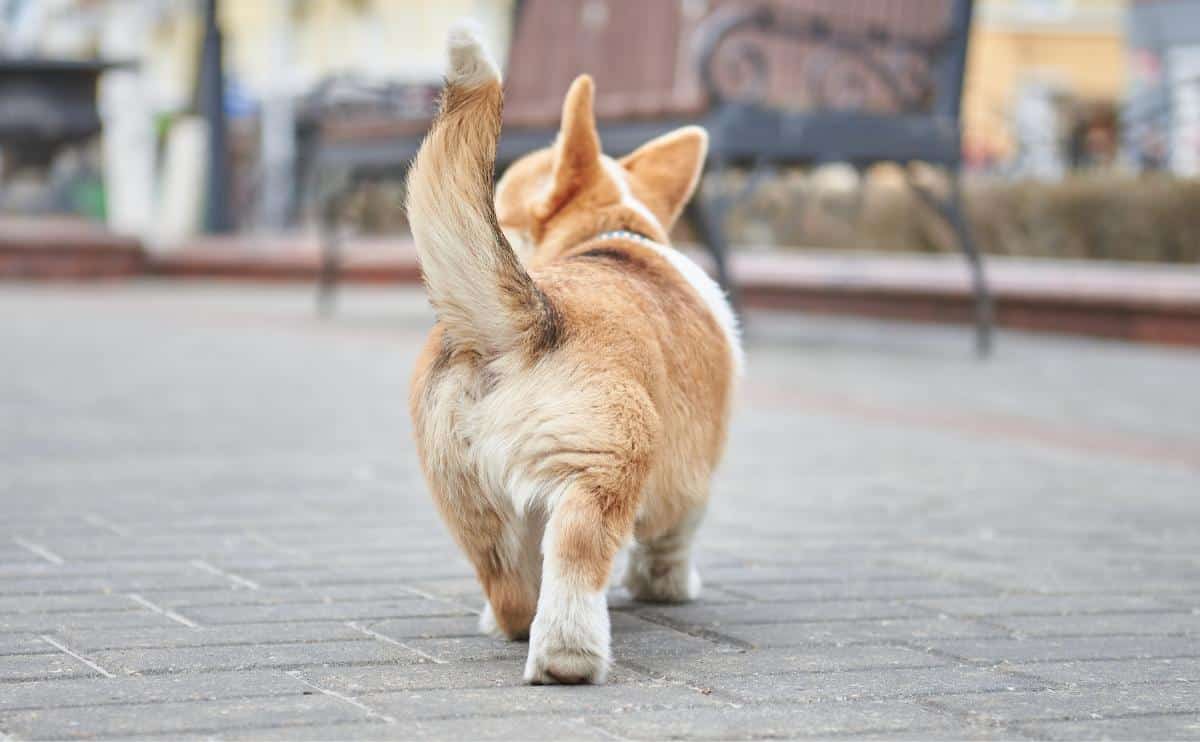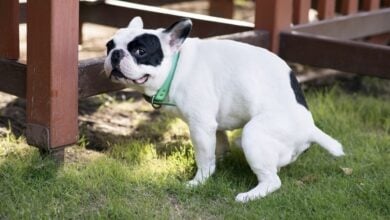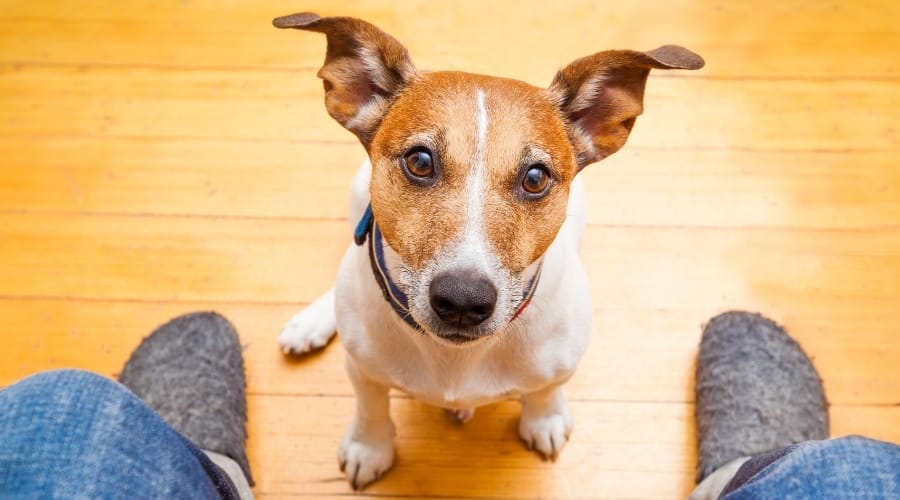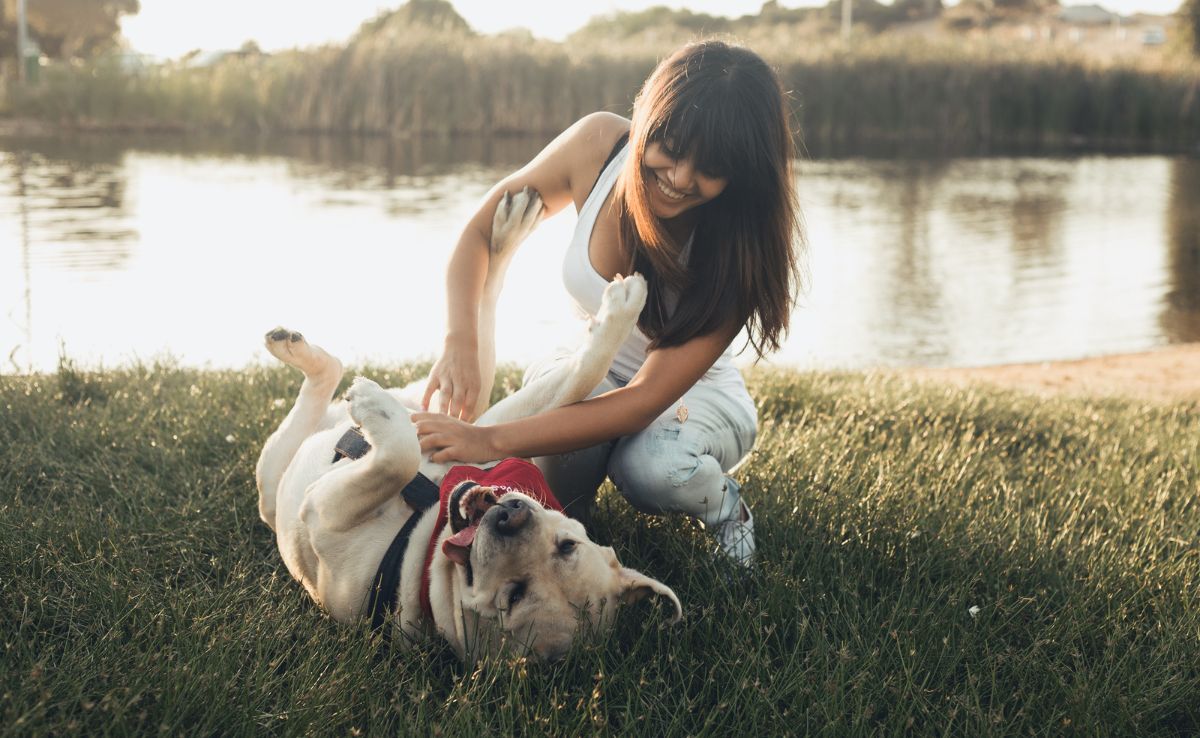When Your Dog’s Love Language Is Physical Touch … And The Pawing Is Driving You Nuts!
When you purchase through links on our site, we may earn a commission. Here’s how it works.
Your pup loves you—like, really loves you. And if their love language is physical touch, you probably know about dog pawing all too well.
Table of Contents
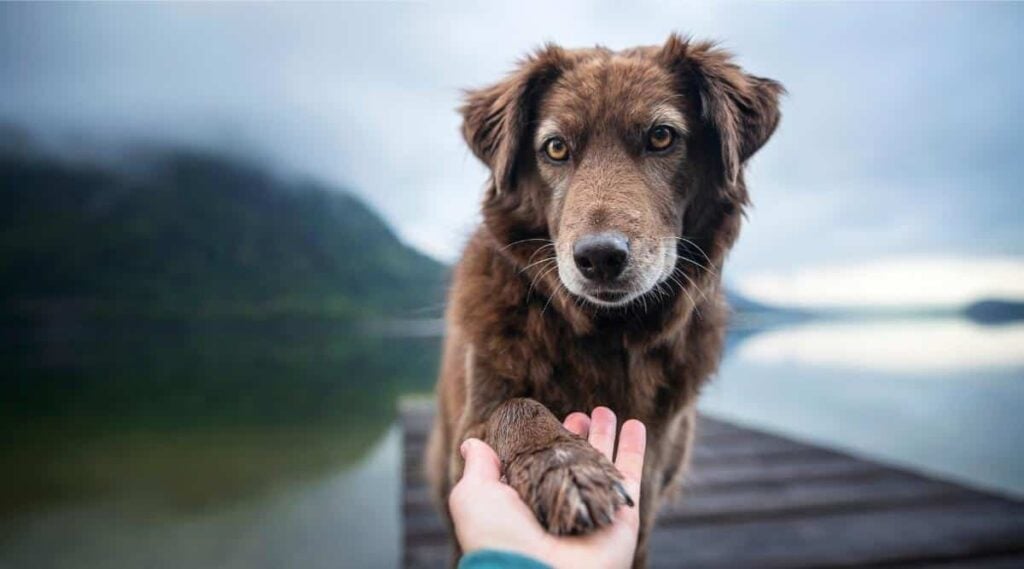
Sure, it’s cute at first. But after the tenth time they smack your leg (or your face) while you’re trying to relax, you might start wondering: why is my dog so obsessed with pawing at me?
Are they asking for belly rubs? Treats? Just demanding attention 24/7?
Dogs use their paws to communicate, and while it’s usually harmless, it can get a little excessive.
We’ll break down the 10 most common reasons your dog won’t stop pawing at you—and what you can do to keep your lovable, needy pup from turning your arms into a scratching post.
Why Does My Dog Keep Pawing At Me? 10 Common Reasons
Dogs have many reasons for pawing, from dominance to affection and beyond. Some owners find it rude and disruptive, while others tolerate it.
Pawing from a small dog may seem harmless, but a large dog’s paws can knock over children, cause scratches, or even lead to minor injuries.
1. They Are Trying To Tell You Something
Every creature has its way of communicating. Humans use words, but dogs rely on body language.
Pawing is one of their most direct ways to get your attention.
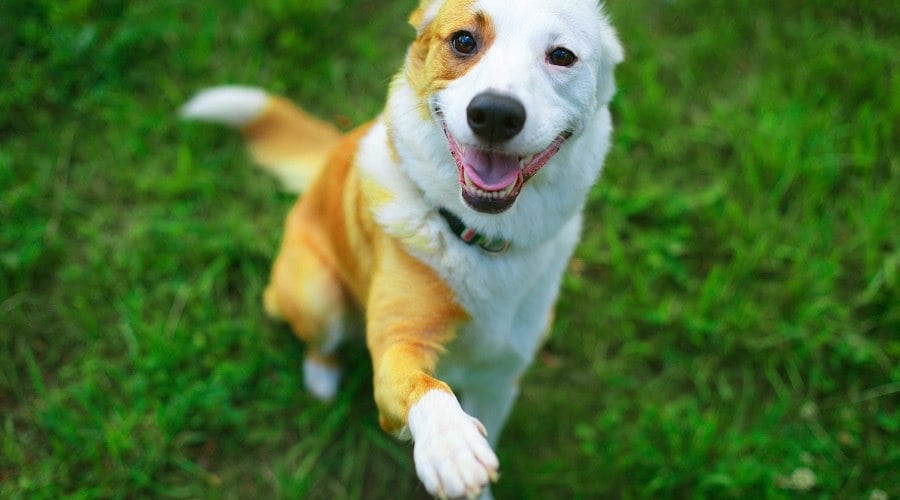
Think of it as trying to converse with someone who doesn’t speak your language. Hand gestures and charades become essential.
For dogs, pawing is their version of a “hand gesture” to communicate a need. They might also tilt their heads or use other expressive behaviors.
Like a toddler tugging on a parent’s leg, a dog pawing at you means they need something. Some dogs paw when they want to go outside, while others use it to ask for a favorite toy.
Over generations, dogs have watched humans communicate with their hands, making it natural for them to do the same.
Our Personal Experience With A Smart Communicator
My Cavalier King Charles Spaniel, Georgie, will paw at me sitting at my desk sometimes when he really needs to go out to potty. He’ll also paw at his doggy door under the stairs, where his leash is, when he needs to go out (or wants something like his treats that are stored there, too).
He’ll paw and paw until he gets our attention and usually won’t stop until he gets what he wants, sometimes pairing it with a bark to really get the point across. Whenever he does it, we say he’s being a good communicator.
If a treat or a crumb of food falls under the sofa or somewhere he can’t get it, he’ll paw and whine, letting us know he needs help getting it (if it’s dog-friendly). So bright—these dogs can’t talk, but they certainly have a way of using gestures to get through to their humans.
– Sadie Cornelius, Canine Journal Creative & Marketing
2. They Want Instant Love & Attention
If you’re spending time with your dog and they paw at you, they’re likely asking for more affection.
Have you ever stopped petting your dog, only to have them immediately place a paw on you? This behavior is their way of saying, “Don’t stop!”
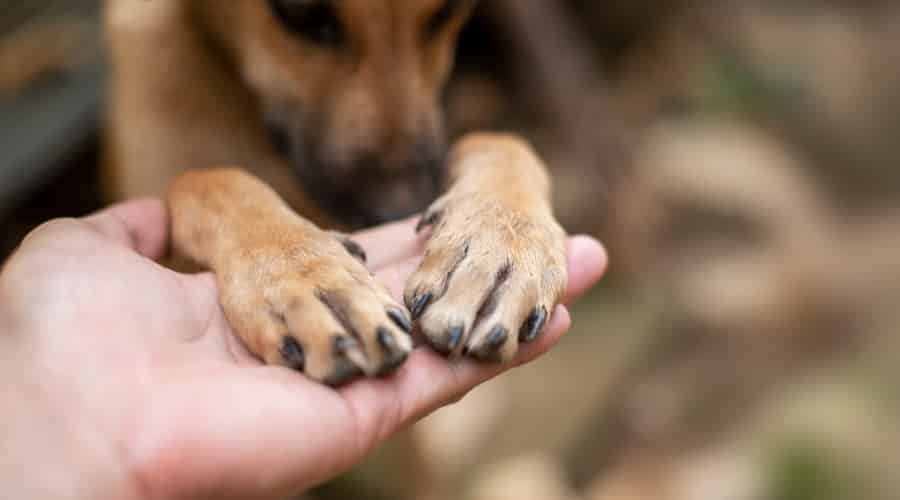
Studies show that petting releases oxytocin, a “feel-good” hormone, in dogs and their owners, so they might also be reciprocating your affection in a way that benefits you both. If you consistently reward this behavior with more attention, they’ll keep using it to get what they want.
Our Personal Experience With A Determined Pawer
My 70-pound hound mix has mastered the art of getting exactly what she wants, whether it’s a walk or my undivided attention.
If I’m sitting on the couch, she’ll trot over, hoist her front legs onto me, give a gentle paw to my chest, and hit me with the look. That signature side-eye that somehow says, “I don’t know who just pawed you, but it definitely wasn’t me.”
If she wants a walk, she’s relentless, pawing at me like she’s filing a formal complaint. But if it’s affection she’s after, I’ll start petting her, only to quickly realize that stopping is not an option.
The moment my hand hesitates, BOOM, paw to the arm, paw to the chest. “Excuse me, I didn’t say you could stop.” It’s like having a very needy, very heavy weighted blanket that comes with demands.
And honestly? I wouldn’t have it any other way.
– Kimberly Alt, Canine Journal Writer & Pet Insurance Expert
3. They Feel Guilty About Something
Sometimes, pawing is a dog’s way of apologizing. If your pup looks guilty while placing a paw on you, they might be asking for forgiveness.
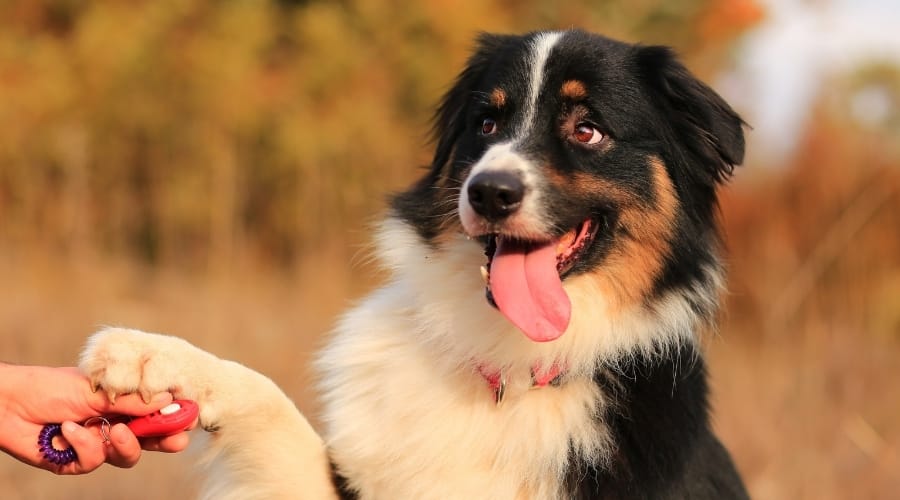
Dogs are experts at winning us over with their sad eyes.
If a guilty-looking dog paws at you and you respond by petting them, they learn that this behavior works to get them out of trouble. Over time, this can reinforce the habit whenever they do something they shouldn’t.
4. They Need Food Or Water Right Now
When it’s close to mealtime, your dog might paw at you as a reminder. Since they can’t use words, they rely on signals like nudging their food bowl or pawing at your leg.
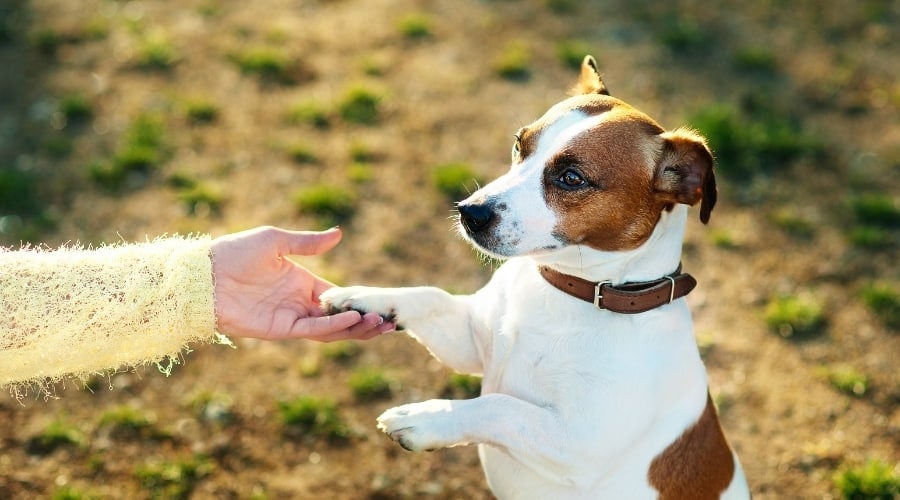
While this behavior might seem harmless, be careful not to encourage demanding behavior.
Some dogs learn to paw aggressively for food or treats, which can turn into an annoying habit. To prevent this, feed your dog on a consistent schedule so they don’t need to remind you.
5. They Know When You’re Feeling Down (Empathy)
Dogs are highly empathetic and pick up on subtle changes in our emotions. If you’re feeling stressed, sad, or anxious, your dog might paw at you as a form of comfort.
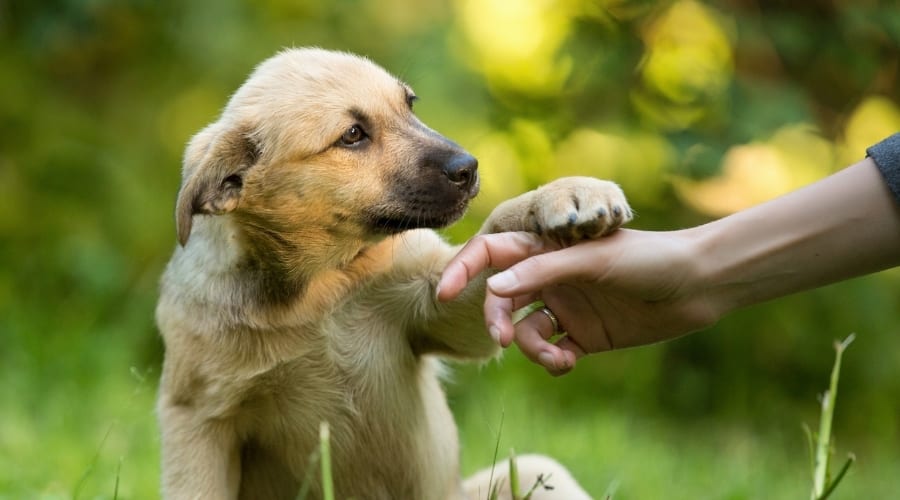
Consider their paw like an extended hug. Your dog doesn’t have words, but this small gesture is their way of saying, “I’m here for you.”
6. They Want To Play—And They Won’t Take No For An Answer
A playful dog will use many tactics to initiate a game, including wagging their tail, bouncing excitedly, or pawing at you. This pushy behavior is often successful.
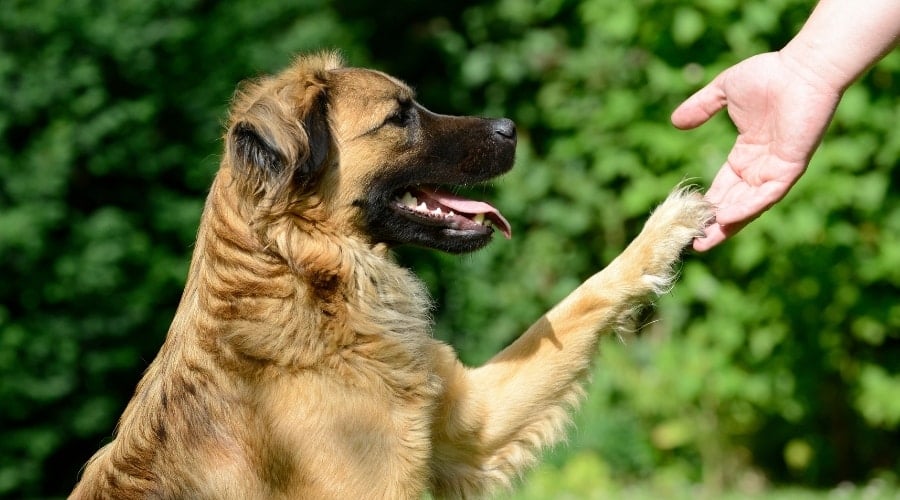
How likely are you to play if your dog brings you a toy and paws at you? Most owners give in, reinforcing this habit.
While it can be charming, be mindful of when and how you respond to avoid encouraging constant demands for playtime.
7. They Are Sassing You
Just like humans, some dogs have more attitude than others. While some pups cower when corrected, others challenge authority.
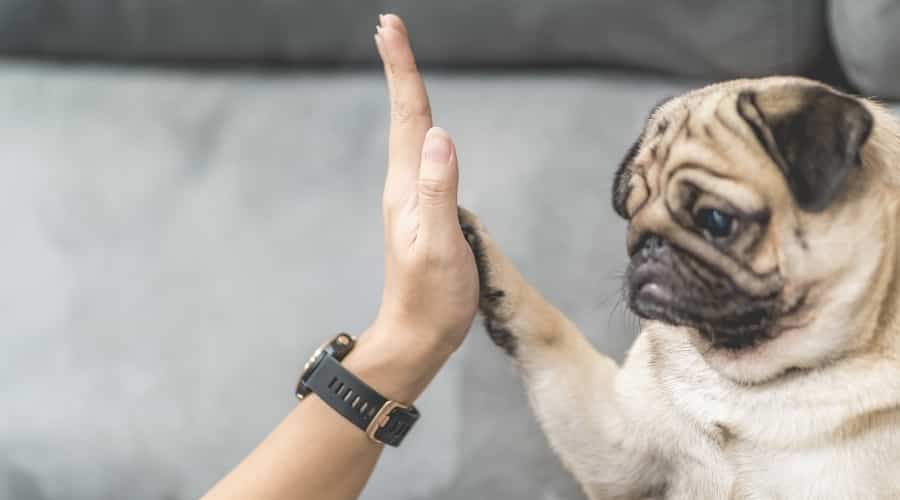
A dog throwing their paw at you while barking or grumbling might not be apologizing—they’re talking back!
Think of it like a teenager rolling their eyes. Some dogs even pair pawing with playful barks, showing their own version of sass.
8. They’ve Learned Pawing Gets A Reaction (Learned Behavior)
Some dogs are naturally more expressive and use their paws frequently. If a dog realizes pawing gets a positive or negative reaction, they’re likely to keep doing it.
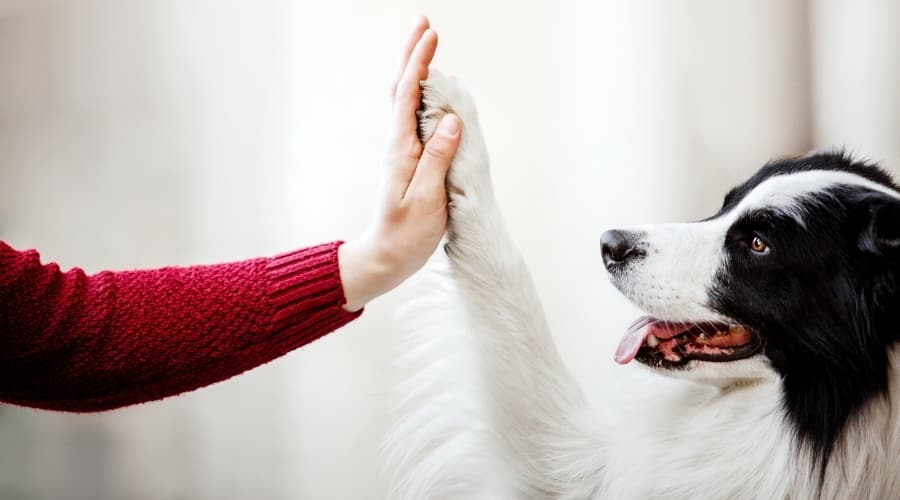
Dogs that paw for attention may lack manners. If you want to reduce this behavior, ignore the pawing and reward calmer communication forms.
Some pet owners purchase dog-talking buttons to train and communicate with their dogs. Our team has reviewed some of the most popular dog-talking buttons available.
9. They See You As The Boss (Seeking Reassurance)
Pawing can be a sign of submission. If a dog places their paw on you with their ears back or their tail tucked, they might be showing respect.
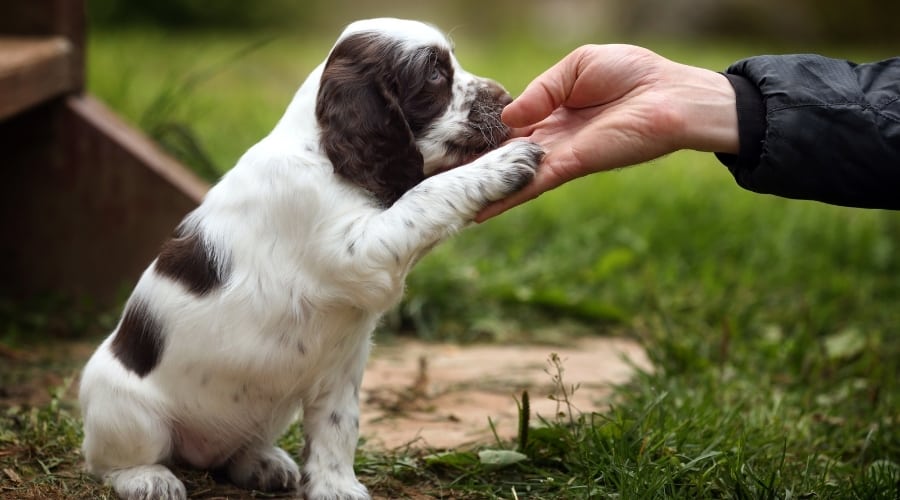
This behavior often appears in dogs that need reassurance. If your pup seems anxious while doing it, they may be seeking comfort and guidance from their trusted leader—you.
10. They Think They Are The Boss (Dominance)
Just as some dogs use pawing to show submission, others use it to assert dominance. A dominant pup might place a paw on another dog to show control in dog-to-dog interactions.
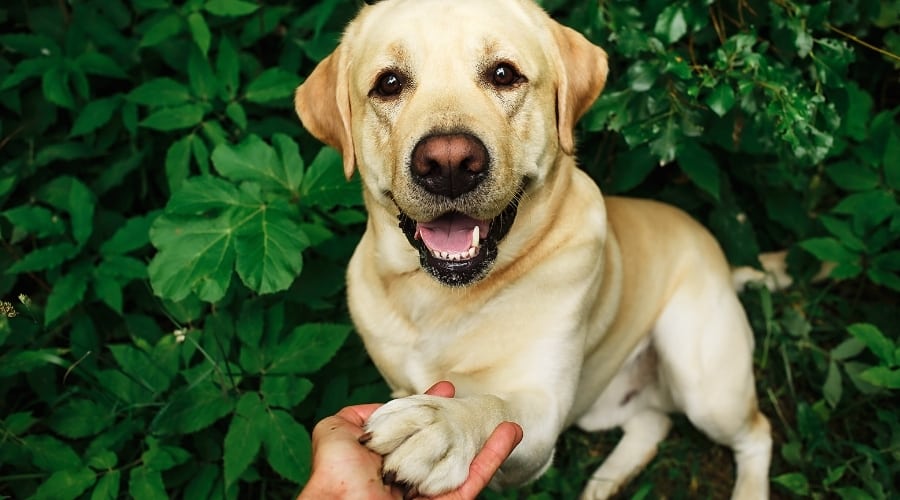
If your dog paws at you while resisting commands, guarding food, or ignoring corrections, they may be testing their rank in your “pack.”
To reinforce leadership, avoid rewarding pushy behavior and use consistent training techniques. Your dog should see you as the leader, not vice versa.
When Does Pawing Become A Problem?
Dogs use their paws to communicate, but when does this endearing habit become disruptive?
While some pawing is harmless and affectionate, excessive or persistent pawing can signal deeper issues. Understanding the difference can help you set boundaries and address any underlying concerns.
Affectionate vs Excessive Pawing
A gentle paw placed on your leg during cuddle time differs from nonstop pawing that demands attention at all hours.
Affectionate pawing happens occasionally and usually stops when you acknowledge your dog. Excessive pawing, on the other hand, can be persistent, pushy, or even frantic.
If your dog constantly paws at you—even after being acknowledged—it may be time to step back and assess what’s really going on.
When Pawing Becomes Disruptive Or Annoying
Pawing becomes a problem when it interferes with your daily routine, causes injury (such as scratches or bruises), or escalates into other demanding behaviors like barking or jumping. A large dog pawing at children or guests can also become a safety concern.
If your dog’s pawing feels more like a demand than a request, it’s time to establish boundaries.
Could Pawing Signal Anxiety Or A Behavioral Issue?
In some cases, excessive pawing isn’t just about getting attention—it can be a sign of anxiety, insecurity, or even compulsive behavior.
Dogs with separation anxiety may paw at their owners for comfort and reassurance. Others may develop obsessive behaviors, using pawing as a coping mechanism when they feel stressed.
Signs that your dog’s pawing might be linked to anxiety or behavioral issues include:
- Pawing paired with whining, pacing, or restlessness
- Inability to settle down, even after getting attention
- Increased pawing in stressful situations, like when you’re about to leave the house
If your dog’s pawing seems excessive, persistent, or emotionally driven, it’s worth exploring training techniques or consulting a professional to help address the root cause.
When Pawing Becomes A Bad Habit
While the occasional paw during petting sessions or sweet moments with your pup can be endearing, it can quickly become an annoying habit. When dogs learn that pawing gets them what they want, they’ll continue using it as a go-to tactic for attention.
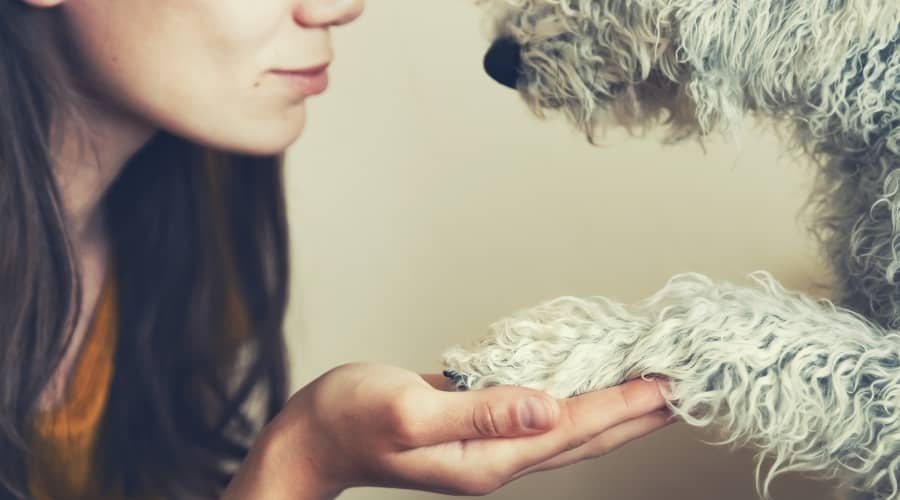
In most cases, pawing is a demand for immediate attention. Allowing this behavior to continue can reinforce pushy tendencies, making it harder to set boundaries.
While we love our pets dearly, creating a balanced relationship built on mutual respect is essential. You wouldn’t tolerate a friend constantly tugging at your arm, so your dog should also learn appropriate ways to seek attention.
How To Stop Excessive Pawing
Breaking this habit can be challenging because we often reinforce it without realizing it.
Think about each time you come home and your dog greets you with excited pawing. While heartwarming, responding reinforces the idea that pawing is an acceptable way to get attention.
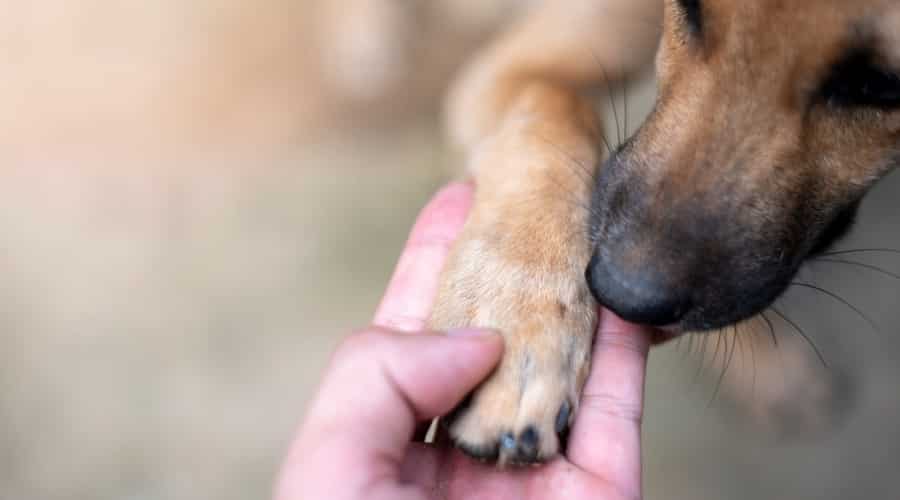
A habit like this usually starts small and grows over time.
A gentle nudge under the table for a bite of your food can escalate into persistent scratching whenever you sit down to eat. Setting clear boundaries early on prevents these behaviors from becoming a long-term issue.
4 Ways To Gently Stop Unwanted Pawing
- Redirect to a positive behavior – When your dog paws at you, immediately ask them to sit instead. Reward calm behavior with attention or treats.
- Delay your response – Gradually increase the time before responding to their request. This teaches them patience and discourages demand behaviors.
- Ignore and reinforce good behavior – If your dog paws for attention, turn away and avoid eye contact. Once they stop and sit calmly, reward them with affection.
- Increase physical and mental stimulation – Excessive pawing may stem from boredom or excess energy. Ensure your dog gets enough exercise and mental engagement through interactive toys or training sessions.
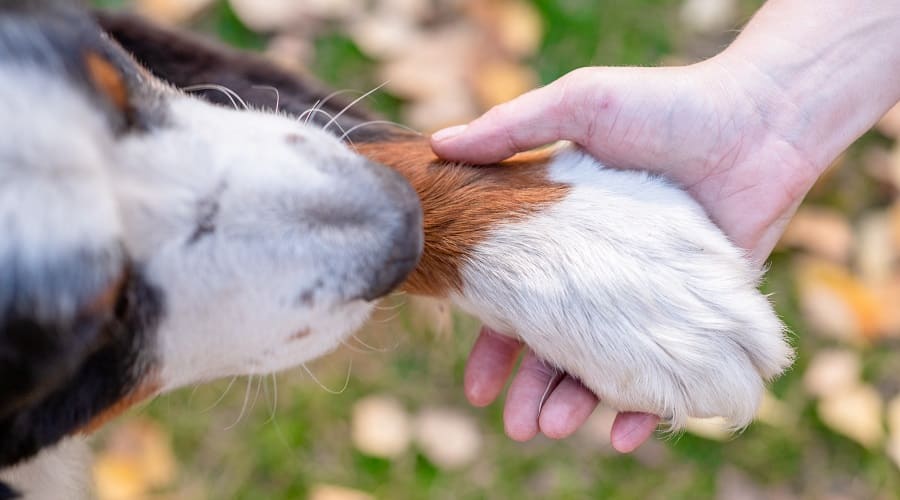
The Difference Between Stopping Pawing & Suppressing Communication
The goal isn’t to eliminate all pawing—dogs use their paws to communicate important things, like needing to go outside or feeling unwell.
Instead, focus on reducing excessive or disruptive pawing while encouraging appropriate ways to express needs. Pay attention to context so you don’t miss important signals.
What If Your Dog Still Won’t Stop?
If your dog continues excessive pawing despite training, consider these possible reasons:
- Medical issues – If pawing is excessive and unusual, consult your vet to rule out any underlying medical concerns.
- Anxiety or stress – Some dogs paw excessively due to separation anxiety or insecurity. Reducing stressors and providing reassurance may help.
- Lack of boundaries – Inconsistent reinforcement can make training ineffective. Ensure all family members follow the same rules.
When To Seek Professional Help
If training and redirection don’t reduce excessive pawing, consult a professional dog trainer or behaviorist.
Persistent pawing could be linked to deeper behavioral issues, such as compulsive behavior or anxiety. A professional can help identify the root cause and provide tailored solutions for your dog’s specific needs.
You could also try an online dog trainer like Doggy Dan for an affordable solution that fits your schedule.
Frequently Asked Questions
If your dog constantly paws at you, you’re not alone. Many pet owners wonder whether this behavior is normal, how to manage it, and what their dog tries to communicate.
While pawing can signify affection, attention-seeking, or discomfort, it’s essential to understand when it’s harmless and when it might signal a deeper issue.
Below are some of the most common questions about why dogs paw and how to handle it. Don’t see yours? Ask us in the comments!
Do Certain Dog Breeds Paw More Than Others?
Yes, some breeds are naturally more prone to using their paws for communication.
Breeds with strong working or herding instincts, such as Border Collies and Australian Shepherds, often use their paws to interact with people and their environment. Companion breeds like Golden Retrievers and Cocker Spaniels may also paw frequently as a way to express affection.
Understanding your dog’s breed tendencies can help determine whether their pawing is instinctual or a learned habit.
Is It Okay to Let My Dog Paw at Me?
Occasional pawing can be harmless and even endearing, especially when your dog uses it as a way to bond with you. However, allowing it consistently can reinforce pushy behavior and lead to excessive demands for attention.
If your dog’s pawing becomes disruptive, scratches you, or interferes with daily activities, it’s best to set boundaries and redirect their behavior through training.
Should I Be Concerned If My Dog Suddenly Starts Pawing More Than Usual?
A sudden increase in pawing could indicate an underlying issue that needs attention. While some dogs become more affectionate or needy over time, a drastic behavior change might signal anxiety, stress, or even a medical problem.
Your dog could be experiencing pain, discomfort, or an issue with their paws, such as an injury or irritation. If your dog’s pawing is accompanied by whining, restlessness, or other unusual behaviors, it’s best to consult a veterinarian to rule out any health concerns.
Why Does My Dog Paw At My Face Instead Of My Leg?
If your dog paws at your face rather than your leg, they may seek a more direct form of attention. This behavior is typical in affectionate dogs trying to get close to their owners or elicit a specific response, like playtime or cuddles.
However, it can also signify overexcitement or a learned behavior from puppyhood. If it becomes excessive, redirect their attention to a more appropriate interaction, such as offering a paw on command rather than allowing unprompted face pawing.
How Can I Tell If My Dog’s Pawing Is A Dominance Behavior?
In some cases, dogs use pawing to assert dominance, similar to how they might place a paw on another dog to establish control.
If your dog’s pawing is firm, persistent, or accompanied by other dominant behaviors—such as ignoring commands, resource guarding, or resisting authority—it could be a sign of an attempt to assert control.
It’s essential to address this behavior with consistent training, clear boundaries, and positive reinforcement to establish yourself as a leader in a respectful and structured way.
Could My Dog’s Pawing Be A Sign Of Pain Or Illness?
Yes, persistent pawing—especially if directed toward a specific part of your body or their own—can be a sign of discomfort.
Dogs may paw at their owners to seek comfort when they’re in pain or feeling unwell. If your dog’s pawing is accompanied by other unusual behaviors, such as whining, lethargy, limping, or loss of appetite, it’s best to consult a veterinarian to rule out any underlying health issues.
How Do I Train My Dog To Stop Pawing For Attention?
Avoid reinforcing the behavior by giving immediate attention when your dog paws at you to stop unwanted pawing.
Instead, reward calm behavior and teach an alternative action, such as sitting or offering a toy. If your dog paws, ignore them and only respond once they stop.
Positive reinforcement, such as treats and praise when they remain calm, helps reinforce good manners. Consistency is key—if everyone in the household follows the same approach, your dog will learn more quickly.
Is There A Way To Redirect My Dog’s Pawing Into A Positive Behavior?
Yes! If your dog paws excessively for attention, you can teach them alternative ways to communicate or seek interaction.
Training your dog to use verbal cues or sit patiently instead of pawing can help reduce the behavior. You can also redirect their energy into interactive activities, such as teaching them to give a high-five on command or rewarding them for using a designated toy instead of their paws.
Find The Best Pet Insurance For Your Dog
Unexpected vet bills can add up quickly, especially if your dog develops a health condition or gets injured. Since pawing can sometimes indicate anxiety, allergies, or joint pain, having a pet insurance plan in place can help cover the costs of diagnosing and treating potential underlying issues.
When choosing pet insurance, consider:
- Coverage options – Does the plan cover accidents, illnesses, hereditary conditions, or even routine care?
- Reimbursement rates – How much will you get back after a vet visit? Plans typically reimburse 70-90% of eligible expenses.
- Deductibles & premiums – Higher deductibles often mean lower monthly costs, but you’ll pay more out of pocket before coverage starts.
- Exclusions & waiting periods – Many policies exclude pre-existing conditions and may require a waiting period before coverage begins.
- Ease of claims process – Look for companies that provide simple online claims submission and fast reimbursements.
Investing in pet insurance ensures you can provide the best care for your dog with less financial stress. If your pup’s pawing behavior turns out to be a sign of an underlying health issue, you’ll be prepared to get them the treatment they need.
Read our pet insurance reviews to get started and get free quotes from many providers by using the form below.
